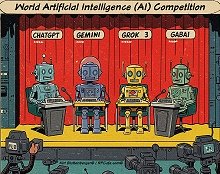Societal Influences
- See Full List of AI Topics -
 Black Tuesday refers to October 29, 1929, when the stock market crashed in
the United States, leading to the Great Depression. It was one of the most
significant financial events in history and had a profound impact on the global
economy. Black Tuesday refers to October 29, 1929, when the stock market crashed in
the United States, leading to the Great Depression. It was one of the most
significant financial events in history and had a profound impact on the global
economy.
The Wall Street Crash of 1929, also known as the Stock Market Crash of 1929,
was a major factor in triggering the Great Depression. It marked the end of the
Roaring Twenties, a decade of economic prosperity and speculative excesses. On
Black Tuesday, stock prices plummeted, and investors lost billions of dollars.
Leading up to the crash, the stock market had experienced a period of
excessive speculation, with many people borrowing money to invest in stocks. The
market was overinflated, and signs of an impending crash started to appear in
September 1929. On October 24, 1929, known as Black Thursday, the market
experienced a sharp decline, but it was followed by a brief recovery. However,
on Black Tuesday, October 29, 1929, panic selling reached its peak, and the Dow
Jones Industrial Average dropped significantly, marking the start of the Great
Depression.
The consequences of the Wall Street Crash were severe and far-reaching. The
stock market collapse wiped out many investors and caused numerous banks to
fail. The crash led to a sharp decline in consumer spending, business failures,
and high unemployment rates. It triggered a worldwide economic downturn, with
countries around the globe facing financial crises.
In response to the Great Depression, governments implemented various measures
to stabilize the economy and prevent future financial disasters. These included
the implementation of banking regulations, the creation of social welfare
programs, and the introduction of fiscal policies aimed at stimulating economic
growth.
The Wall Street Crash of 1929 and the subsequent Great Depression served as
important lessons for economists, policymakers, and financial institutions,
shaping future regulations and approaches to economic stability.
 This content was generated by primarily
the ChatGPT (OpenAI), and/or
Gemini (Google), and/or
Arya (GabAI), and/or
Grok (x.AI), and/or DeepSeek artificial intelligence (AI) engine.
Some review was performed to help detect and correct any inaccuracies; however,
you are encouraged to verify the information yourself if it will be used for critical
applications. In some cases, multiple solicitations to the AI engine(s) was(were) used to assimilate
final content. Images and external hyperlinks have also been added occasionally.
Courts have ruled that AI-generated content is not subject to copyright restrictions,
but since I modify them, everything here is protected by RF Cafe copyright. Many
of the images are likewise generated and modified. Your use of this data implies
an agreement to hold totally harmless Kirt Blattenberger, RF Cafe, and any and all
of its assigns. Thank you. Here are the major categories. This content was generated by primarily
the ChatGPT (OpenAI), and/or
Gemini (Google), and/or
Arya (GabAI), and/or
Grok (x.AI), and/or DeepSeek artificial intelligence (AI) engine.
Some review was performed to help detect and correct any inaccuracies; however,
you are encouraged to verify the information yourself if it will be used for critical
applications. In some cases, multiple solicitations to the AI engine(s) was(were) used to assimilate
final content. Images and external hyperlinks have also been added occasionally.
Courts have ruled that AI-generated content is not subject to copyright restrictions,
but since I modify them, everything here is protected by RF Cafe copyright. Many
of the images are likewise generated and modified. Your use of this data implies
an agreement to hold totally harmless Kirt Blattenberger, RF Cafe, and any and all
of its assigns. Thank you. Here are the major categories.
Electronics & High Tech
Companies | Electronics &
Tech Publications | Electronics &
Tech Pioneers | Electronics &
Tech Principles |
Tech Standards Groups &
Industry Associations | Societal
Influences on Technology
 While working on an
update to my
RF Cafe Espresso Engineering Workbook project to add a couple calculators
about FM sidebands (available soon). The good news is that AI provided excellent
VBA code to generate a set of
Bessel function plots. The bad news is when I asked for a
table
showing at which modulation indices sidebands 0 (carrier) through 5 vanish,
none of the agents got it right. Some were really bad. The AI agents typically
explain their reason and method correctly, then go on to produces bad results.
Even after pointing out errors, subsequent results are still wrong. I do a
lot of AI work and see this often, even with subscribing to professional
versions. I ultimately generated the table myself. There is going to be a
lot of inaccurate information out there based on unverified AI queries, so
beware. While working on an
update to my
RF Cafe Espresso Engineering Workbook project to add a couple calculators
about FM sidebands (available soon). The good news is that AI provided excellent
VBA code to generate a set of
Bessel function plots. The bad news is when I asked for a
table
showing at which modulation indices sidebands 0 (carrier) through 5 vanish,
none of the agents got it right. Some were really bad. The AI agents typically
explain their reason and method correctly, then go on to produces bad results.
Even after pointing out errors, subsequent results are still wrong. I do a
lot of AI work and see this often, even with subscribing to professional
versions. I ultimately generated the table myself. There is going to be a
lot of inaccurate information out there based on unverified AI queries, so
beware.
|











